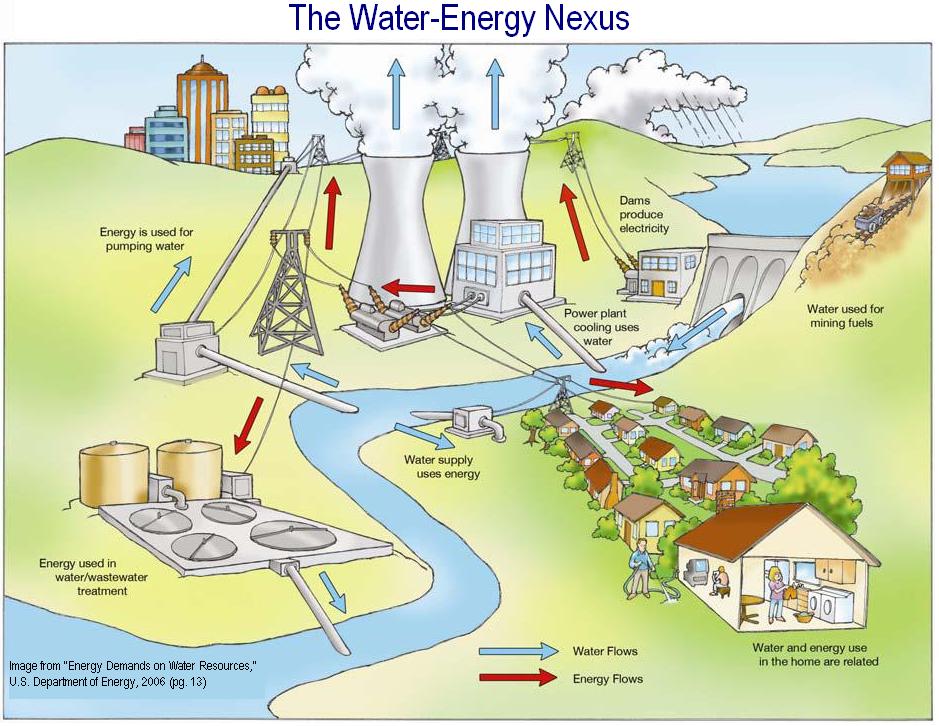 Over the past several weeks, I’ve written a lot about the intimate and inextricable connection between energy and water. The energy-water nexus involves a number of technologies, environmental factors and stakeholders. Thus, it’s no surprise that water and energy’s fundamental connection has eluded policymakers for so long. With this post, I review the lessons discussed so far, so that policymakers can understand the key issues surrounding the energy-water nexus and what’s at stake if we fail to act now.
Over the past several weeks, I’ve written a lot about the intimate and inextricable connection between energy and water. The energy-water nexus involves a number of technologies, environmental factors and stakeholders. Thus, it’s no surprise that water and energy’s fundamental connection has eluded policymakers for so long. With this post, I review the lessons discussed so far, so that policymakers can understand the key issues surrounding the energy-water nexus and what’s at stake if we fail to act now.
The Bottom Line
Conventional electricity sources, like coal, natural gas and nuclear power plants, require an abundance of water — about 190 billion gallons per day. Because the majority of our electricity comes from these sources, high energy use strains the water system and contributes to Texas’ prolonged drought. Coincidentally, extreme drought could force power plants to shut down.
Climate change is having a profound effect on our weather patterns, making extreme heat and drought more common in Texas and throughout the Southwest. If we don’t set the energy-water system on a sustainable course, we risk a compounded problem.
Finding a solution will require unconventional cooperation and swift action.
To reduce the water footprint of our energy sources, the water consumption of electricity sources should be an integral part of long-term electricity planning, and be reflected in competitive electricity markets.
Today, the lower water impact of wind and solar facilities versus a coal plant is not accounted for in the energy market or by most electricity planners. Renewable energy sources, such as wind and solar photovoltaics, use essentially no water, giving them a vast advantage over fossil-fuel electricity sources. Integrating water use with electricity planning and the wholesale electricity market would help reveal synergies that show just how competitive renewables are with fossil fuels, and speed our transition to a clean energy economy.
Energy efficiency upgrades and reductions in energy use through demand response are some of the most cost-effective energy resources we have. These innovative technologies reduce Texas’ reliance on fossil-fuel electricity and actually bolster our water supply and cut harmful carbon emissions at the same time. Accounting for water use would go a long way towards integrating these unconventional “negawatt” energy resources (technologies that save energy through efficiency) into the power market.
The more we include water and other environmental considerations in the energy market—the faster we can transition to a cleaner, more sustainable energy system.
Of course, it’s a two-way street. The energy and greenhouse gas (GHG) emissions impact of the water system should be a major part of water planning. When water planners consider energy use, they discover unique opportunities to cut energy costs and reduce emissions.
Mirroring the case for energy, water conservation is the best way to preserve our water supply and reduce the energy required for water operations. Simple strategies, such as using reclaimed wastewater for irrigation, can vastly reduce a city’s water needs. State and municipal planners should always weigh the benefits of water conservation initiatives versus building a new energy-intensive water treatment plant or pipeline.
It’s all connected. Conserving energy saves water and conserving water saves energy.
If we break down the longstanding division between energy and water planning, we reveal the most beneficial steps to improve the efficiency of the energy-water system.
San Antonio: A Model for Energy-Water Co-Management
The city of San Antonio offers a good example of effective energy-water co-management. San Antonio Water System (SAWS) prioritizes energy management and has won numerous awards for its energy savings. The water utility’s most innovative project to date is Dos Rios, a combined sewage treatment and biogas plant that reduces harmful air pollution and generates revenue from the sale of biogas. CPS Energy, the city’s municipally-owned electric utility, even installed a 20 megawatt solar farm at the facility to further cut down GHG emissions and water-use.
San Antonio is a unique case: it has the jurisdictional advantage of local control over both its electricity and water. The city maintains control of its electric utility due to an exception for municipal utilities in Texas’ 1999 electricity deregulation bill, and water utilities remain under municipal control throughout the state. CPS Energy and SAWS recognize each other as among their largest customers, and coordinate their planning cycles accordingly.
The city also benefits from a uniquely water-smart population. Until recently, San Antonio received all its water from one source, the Edwards Aquifer. Because the aquifer is a vital water source for a large portion of South-Central Texas, San Antonio residents were raised with water conservation in mind to preserve the aquifer.
The unique factors contributing to San Antonio’s leadership in energy-water co-management can’t be seamlessly transplanted into other cities and counties. The regulatory division between electric and water utilities is complex and varies from state to state. Nevertheless, San Antonio embodies the best practices that could be adopted and applied to many cities’ unique energy-water challenges.
Facing the energy-water nexus head on will take a monumental effort from the highest levels of government. We’re just now realizing the profound connection between energy and water use —but the energy-water nexus will be with us for some time. Climate change is accelerating, and we can expect drought to become more common in the future.
We have to emphasize energy and water co-management as the nation’s energy system slowly evolves and prioritize low-water and low-carbon options like wind and solar. Leaders at the local, state, national and international levels should bridge the divide between energy and water as they develop solutions to transform the global energy system and cope with a changing climate.
This is one of a group of posts that examines the energy-water nexus, Texas’ current approach to energy and water policy and what Texans can learn from other places to better manage its vital resources.











2 Comments
“Diminishing fresh water aquifers, drought, and competing agricultural demands present an urgent need for the Federal government to take the lead in identifying what water resources we have and how best to use and protect those resources.
Vital water data has yet to be gathered by agencies of the government. The United States Geological Survey (USGS) has not been funded adequately to gather thisinformation. We do not have a thorough understanding of groundwater resources and the interconnection of aquifers and yet we continue to drill shale gas wells and frack them without this essential information.
The U.S. is spending a water budget without understanding how much water is available or what the use of water in energy production will mean for local communities, agriculture, or other commercial uses.” Americas Clean Energy Agenda
I don’t have to tell you that the Southwest is in the midst of a record drought, some 14 years in the making, which means the water supply for many Western states – California, Arizona, Utah, Nevada – is drying up. Last month the Bureau of Reclamation announced they’re cutting the flow of water into Lake Mead, which has already lost 100 feet of water since the drought began.
What happens if the Southwest drought does not end soon?
Will we keep using 3 to 6 million gallons of Clean Water per Fracked well, to extract natural gas?
This petition will ask the California Regulators and Law makers to allocate Renewable Portfolio Standards to Ca. home owners, the RPS is the allocation method that is used to set aside a certain percentage of electrical generation for Renewable Energy in the the State.
The State of California has mandated that 33% of its Energy come from Renewable Energy by 2020.
The state currently produces about 71% of the electricity it consumes, while it imports 8% from the Pacific Northwest and 21% from the Southwest.
This is how we generate our electricity in 2011, natural gas was burned to make 45.3% of electrical power generated in-state. Nuclear power from Diablo Canyon in San Luis Obispo County accounted for 9.15%, large hydropower 18.3%, Renewable 16.6% and coal 1.6%.
There is 9% missing from San Onofre and with the current South Western drought, how long before the 18.3% hydro will be effected ?
Another generator of power that jumps out is natural gas, 45.3%, that is a lot of Fracked Wells poisoning our ground water, 3 to 6 million gallons of water are used per well. If Fracking is safe why did Vice Pres Cheney lobby and win Executive, Congressional, and Judicial exemptions from:
Clean Water Act.
Safe Drinking Water.
Act Clean Air Act.
Resource Conservation and Recovery Act.
Emergency Planning Community Right to Know Act.
National Environmental Policy Act.
“Americans should not have to accept unsafe drinking water just because natural gas is cheaper than Coal. the Industry has used its political power to escape accountability, leaving the American people unprotected, and no Industry can claim to be part of the solution if it supports exemptions from the basic Laws designed to ensure that we have Clean Water and Clean Air” Natural Resources Defense Council.
We have to change how we generate our electricity, with are current drought conditions and using our pure clean water for Fracking, there has to be a better way to generate electricity, and there is, a proven stimulating policy.
The Feed in Tariff is a policy mechanism designed to accelerate investment in Renewable Energy, the California FiT allows eligible customers generators to enter into 10- 15- 20- year contracts with their utility company to sell the electricity produced by renewable energy, and guarantees that anyone who generates electricity from R E source, whether Homeowner, small business, or large utility, is able to sell that electricity. It is mandated by the State to produce 33% R E by 2020.
FIT policies can be implemented to support all renewable technologies including:
Wind
Photovoltaics (PV)
Solar thermal
Geothermal
Biogas
Biomass
Fuel cells
Tidal and wave power.
There is currently 3 utilities using a Commercial Feed in Tariff in California Counties, Los Angeles, Palo Alto, and Sacramento, are paying their businesses 17 cents per kilowatt hour for the Renewable Energy they generate. We can get our Law makers and Regulators to implement a Residential Feed in Tariff, to help us weather Global Warming, protect our communities from grid failures, and generate a fair revenue stream for the Homeowner.
We also need to change a current law, California law does not allow Homeowners to oversize their Renewable Energy systems.
Campaign to allow Californian residents to sell electricity obtained by renewable energy for a fair pro-business market price. Will you read, sign, and share this petition?
http://signon.org/sign/let-california-home-owners
I have often wondered the feasibility for the US to consider networking of our nations rivers to enable water to be diverted in channels going east and west and some reservoirs. These channels could reduce down stream flooding, reservoirs to supply drought areas and water to hydro-electric plants. The channels could also serve as an efficient alternative to trucking on our highways. I would also believe it would provide some climate change that may also temper weather and reduce tornadoes. The project would provide a service to our nation as well as professional and skilled jobs for many.